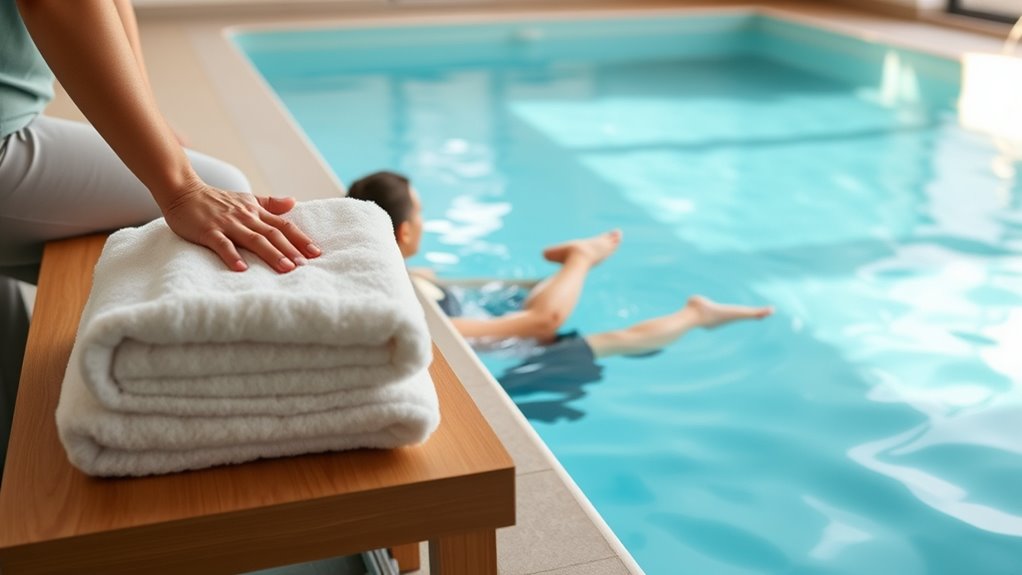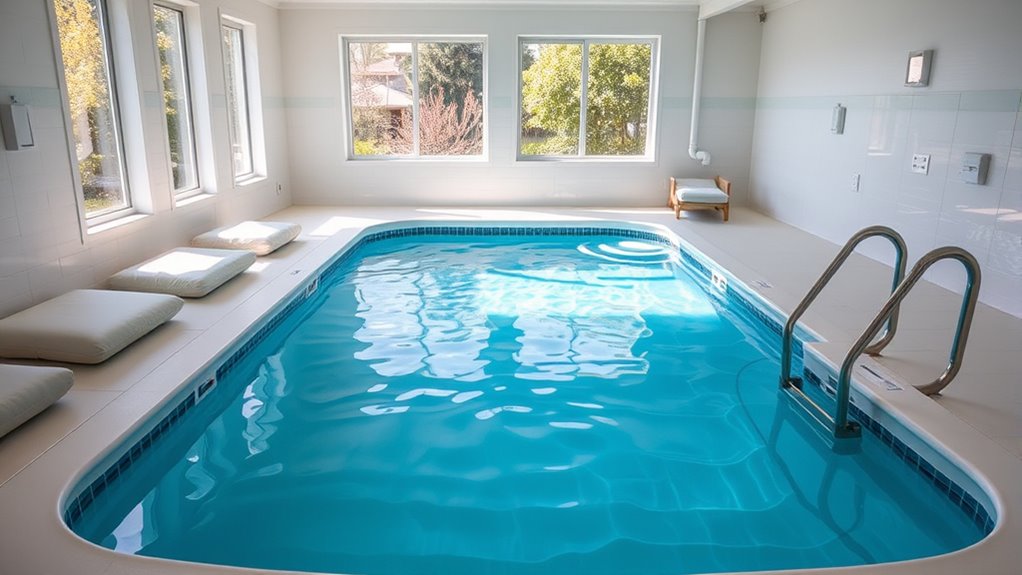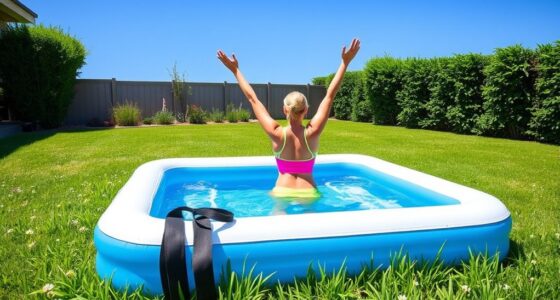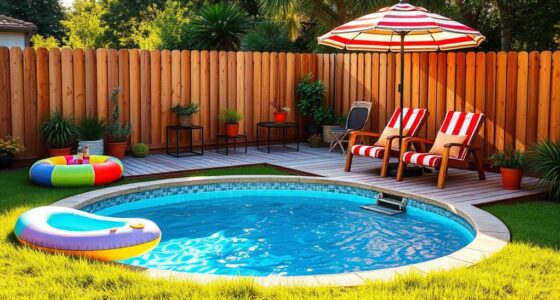A compact pool can be a great aid to your recovery, providing a controlled and accessible space for hydrotherapy and gentle exercises tailored to your needs. Small pools help improve mobility, reduce pain, and increase joint flexibility through water-based activity. With proper water quality, regular maintenance, and thoughtful design, they create a soothing environment that supports healing and comfort. If you want to discover more about setting up and maintaining an effective therapy pool, keep exploring the options available.
Key Takeaways
- Small pools provide a controlled environment ideal for gentle, targeted water therapy sessions to support recovery.
- They help reduce pain and improve mobility by offering low-impact exercises in shallow water.
- Proper water quality and filtration in small pools ensure a safe, hygienic setting for rehabilitation.
- Accessibility features like handrails and steps make therapy safer and easier for individuals with mobility challenges.
- Regular maintenance and tailored design enhance the pool’s effectiveness in aiding recovery and preventing injuries.

Small pools are becoming an increasingly popular option for therapy, offering a private and accessible space for water-based treatments. If you’re considering this route, you’ll find that a compact pool can be a practical tool to aid recovery, improve mobility, and reduce pain. One of the main advantages is hydrotherapy benefits, which include enhanced circulation, decreased muscle tension, and improved joint flexibility. The soothing nature of water makes it easier to perform gentle exercises without putting excessive strain on your body. Plus, the controlled environment allows you to tailor your therapy sessions to your specific needs, whether you’re recovering from an injury or managing chronic pain. Additionally, high refresh rates in some pool filtration systems can help maintain water quality more effectively, ensuring a safer environment for therapy. To maximize these benefits, proper pool maintenance is essential. Regular cleaning prevents the buildup of bacteria and algae, ensuring the water remains safe and inviting. You should check and balance the pH levels frequently, aiming for a range of 7.2 to 7.8, to keep the water comfortable and prevent skin irritation. Filtering systems need to run consistently, ideally for at least 8-12 hours daily, to keep the water clear and free of debris. If you notice cloudy water or strange odors, it’s a sign to test the chemistry and add appropriate chemicals. Maintaining proper water chemistry is vital for your health and the longevity of your pool equipment. Additionally, you should pay attention to the physical condition of your pool components. Inspect the pump, filter, and heater regularly for signs of wear or leaks, and replace parts promptly to avoid disruptions during your therapy sessions. Covering your pool when not in use can reduce debris accumulation and evaporation, further easing maintenance efforts. Investing in a good-quality cover also helps maintain water temperature, which is important for comfort and consistent therapy sessions. When planning your pool setup, consider the size and depth that best suits your therapy routines. A small, shallow pool allows you to sit comfortably and perform targeted exercises, making it easier to focus on specific areas needing rehabilitation. Keep in mind that accessibility features, like handrails or steps, can enhance safety and ease of use. Incorporating these practical tips ensures your small pool remains a beneficial, stress-free addition to your recovery process. Overall, with proper maintenance and thoughtful planning, a compact pool can be a highly effective tool in your journey toward improved health and mobility.
Frequently Asked Questions
What Are the Minimum Size Requirements for a Therapeutic Small Pool?
When considering a therapeutic pool, you wonder about the minimum size requirements. You should look into pool dimensions that suit your needs, typically aiming for a shallow end of about 3 to 4 feet and a length of at least 8 to 12 feet for effective therapy sessions. While size regulations vary by location, ensuring your pool meets safety standards and fits your space is essential for safe and effective recovery.
How Much Does Installing a Small Therapy Pool Typically Cost?
Imagine stumbling upon a therapy pool that could transform your recovery journey. Typically, installing a small therapy pool costs between $3,000 and $15,000, depending on size and features. You’ll need to think about ongoing expenses like pool maintenance and maintaining ideal water temperature. These factors influence your overall cost and experience, ensuring your pool remains safe and effective for therapy sessions.
Are Portable Small Pools Effective for Physical Therapy Treatments?
Portable pools offer great therapy accessibility, making them effective for physical therapy treatments. You can easily set up and use them at home, providing the portability benefits that allow you to incorporate therapy into your daily routine. These pools help reduce joint stress and improve mobility, aiding recovery. If you’re looking for a convenient solution, portable small pools can be a practical, cost-effective way to support your healing process.
What Safety Features Are Essential for Therapy Pools?
You should prioritize vital safety features for therapy pools, like non-slip surfaces and sturdy handrails, to prevent accidents. Proper pool maintenance is essential, so ensure regular water filtration to keep the water clean and clear. Installing an automatic shut-off system adds extra safety, especially during emergencies. These features help create a secure environment, allowing you to focus on your recovery while minimizing risks.
Can Small Pools Be Used for Aquatic Therapy at Home?
Imagine your home as a sanctuary, where a small pool becomes a gentle stream guiding your recovery. Yes, you can use a compact pool for aquatic therapy at home. Keep in mind, proper pool maintenance guarantees safety, and maintaining the right water temperature helps soothe muscles and joints. With attention to these details, your personal aquatic oasis can support healing and provide a calming, restorative space.
Conclusion
Imagine stepping into a small pool, where gentle waters cradle your body like a soothing embrace. These compact pools become your personal oasis, turning recovery into a dance of fluid motion and healing. As you glide through the water, you’ll find your strength blooming like spring flowers after a long winter. Small pools for therapy aren’t just a tool—they’re a gateway to rediscovering your energy, turning the journey of healing into a invigorating, revitalizing tide.









